BOEING B-29 SUPERFORTRESS FIRST FLIGHT
Seattle, Washington State • September 21, 1942
On this date Boeing’s largest-to-date, 4‑engine heavy bomber lifted off on its maiden flight from its namesake’s airfield in Seattle, Washington. Three years earlier the forerunner of the U.S. Army Air Forces had expressed its interest in a replacement bomber for the company’s first 4‑engine heavy bomber, the B‑17 Flying Fortress, which had just entered full-scale production. In December 1939 4 aircraft manufacturers had submitted designs for a “superbomber” to the Army Air Corps. Boeing nudged out its competitor, California-based Consolidated Aircraft Corporation, manufacturer of what would enter Allied bomber services in World War II as the B‑24 Liberator. In August 1940 the Seattle company received an order for 2 flying prototypes, designated XB‑29. (Consolidated continued in the design and manufacturing race as a backup to Boeing, working on its Model 33, later to become the B‑32 Dominator.) In May 1941 Boeing received an order for 250 production Superfortresses, the name continuing the pattern Boeing had started with its predecessor, the B‑17 Flying Fortress. The B‑29 production order was increased to 500, shifting into full gear the month following Japan’s December 7, 1941, attack on U.S. naval and air facilities at Pearl Harbor, Hawaii.
Boeing successfully produced a long-range, high-flying weapons delivery platform with capabilities so advanced that it required a national revolution in engineering, aerodynamics, manufacturing, electronics, material, and operation. The manufacturing task itself was immense, involving 4 main-assembly facilities at Renton, Washington; Wichita, Kansas (both Boeing plants); Marietta, Georgia (Bell Aircraft); and Omaha, Nebraska (Glenn L. Martin). Boeing built 2,766 B‑29s at its plants, Bell 668 B‑29s in Georgia, and Martin 536 B‑29s in Nebraska, including 57 of the 65 Silverplate versions. Hurried development and all sorts of challenging production-line changes required the airframe manufacturers to fly their aircraft directly to modification depots for extensive rebuilds to incorporate the most recent hardware and analog software releases before the planes entered service. Thousands of subcontractors were integrated into the supply chain.
Boeing’s state-of-the-art Superfortresses never saw service over Europe, as originally intended, but only in the Asia Pacific Theater. (Thailand felt the first B‑29 stings followed by Japan 10 days later.) When flying at high altitude, Japanese fighter planes could barely reach U.S. B‑29 bomber streams, and at lower altitudes computers allowed a single gunner to operate 2 or more defensive turrets simultaneously. Defying common practice, Maj. Gen. Curtis LeMay, hard-driving commander of XXI Bomber Command, ordered the removal of most of the defensive equipment on his aircraft and flew his fleet of Superforts at low altitudes for greater distances and often at night, unloading incendiary instead of heavier high-explosive bombs.
In August 1944 5 B-29 launch sites were relocated to the Mariana Islands in the Western Pacific Ocean, less than 1,500 miles/2,414 km from the Japanese capital of Tokyo. LeMay swiftly moved his plan to bomb all of Japan’s major population centers and obliterate its industrial, rail, port, and shipping assets to another, scarcely imaginable level. The high point was reached on August 6 and 9, 1945, when, just as U.S. President Harry S. Truman had forewarned, 2 Japanese cities suffered “prompt and utter destruction” by the most horrifying bomb ever devised for use against a foe. Hiroshima’s and Nagasaki’s awful fate, together with the appearance of Soviet soldiers across the Sea of Japan that separated the Home Islands from the Chinese mainland, persuaded a reluctant Emperor Hirohito (posthumously referred to as Emperor Shōwa) to order his armed forces to stand down. A 7‑year American military occupation of Japan under Gen. Douglas MacArthur enacted widespread military, political, economic, and social reforms, setting the former warrior nation on a democratic path to prosperity and peace with its neighbors.
Boeing B-29 Superfortress Heavy Bomber
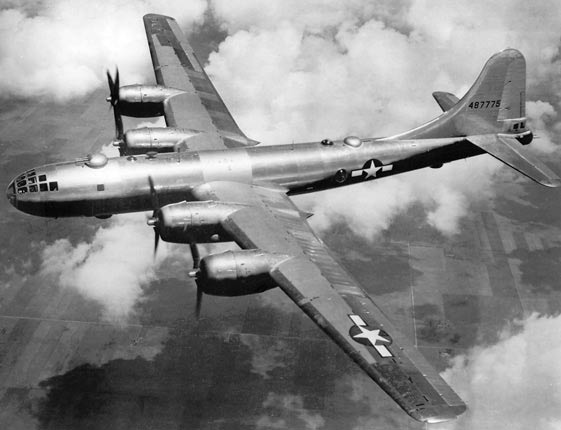 |
Above: By standards of its time, the Boeing B‑29 Superfortress was a monstrous warbird: 99 ft./30 m long, with a wingspan of 141 ft./43 m, it rose nearly 28 ft./8.46 m) off the ground. It weighed over 32 tons empty and nearly 63 tons fully loaded. It carried a crew of 11. Four-bladed propellers, each 16.56 ft./5.05 m in diameter, were powered by 4 Curtis-Wright R‑3350‑23 or ‑57 Duplex-Cyclone 8‑cylinder air-cooled turbosupercharged radial piston engines providing 2,200 hp/1,618 kW each. Cruising speed was 220 mph/350 km/h and maximum speed was 357 mph/575 km/h. Depending on bomb payload and flying altitude, the aircraft could carry between 5,000 lb./2,300 kg (high altitude) and 12,000 lb./5,400 kg (medium altitude). The B‑29 Silverplate version delivered the 2 atomic bombs dropped on the Japanese cities of Hiroshima (Little Boy at 9,700 lb./4,400 kg) and Nagasaki (Fat Man at 10,800 lb./4,900 kg) on August 6 and 9, 1945, respectively. A technological marvel for its day, the 3 separate crew areas were pressurized, allowing for a service ceiling of 31,850 ft./9,710 m. Instead of manning traditional bulky turrets, gunners used remote control to fire their dozen 12.7 mm machine guns and the single 20 mm cannon located in the tail. The tail gunner’s pressurized area could only be exited during unpressurized flight. Gunners sat in the back of the plane, where there were bunks for resting during long missions. Two enormous weapons bays carried the B‑29’s bombload. Some B‑29s were fitted with pneumatically operated bomb bay doors that could be snapped shut in less than a second.
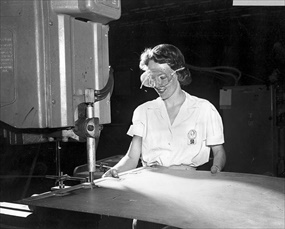 | 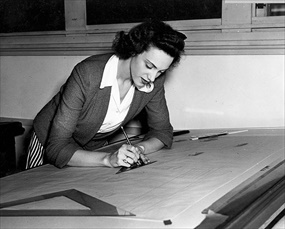 |
Left: The biggest and most technologically advanced airplane ever built during World War II cost $3 billion to design and produce (equivalent to over $53.6 billion in 2025), exceeding by more than 3 times the Manhattan (atomic bomb) project. The B‑29 program required an immense workforce, not only in the 4 B‑29 main-assembly facilities but in the thousands of subcontractor plants and workshops spread across the nation. In the case of Bell Aircraft’s B‑29 plant in Marietta, Georgia (now operated by Lockheed Martin), the U.S. government paid $72 million to build the 3.2‑million‑sq.‑ft./2,972,897‑sq.‑meter plant in farmland Bell chose 15 miles/24 km from the state capital, Atlanta. Most of Bell’s 28,000 employees had not finished high school; many had only an 8th grade education. More than a few workers signed their time cards with an “X.” Although ex-farmhands might be mechanically inclined, special training schools were needed to teach rudimentary and advanced skills in engineering, mathematics, aerodynamics, welding, electronics, operating lathes and cutting sheet metal, and the like. Huge new employment opportunities thus opened up at the Marietta B‑29 plant, especially for women who comprised 37 percent of the Marietta workforce owing to so many men in the armed services. Marietta’s African Americans, too (2,000 in January 1945), reaped rewards, though “Jim Crow” laws were enforced, among them requiring segregated restrooms and water fountains. Contrary to popular myth the typical female aircraft worker did not rivet, though one 81‑year-old woman did just that as she handled rivet guns that weighed as much as 15 lb./6.8 kg. The woman in this photo is operating a spot-welding machine.
![]()
Right: Aside from secretarial/cafeteria jobs, women at all 4 B‑29 main-assembly plants worked as engineers, tool designers, draftswomen like the one shown in this photo, estimators, production illustrators, bicycle or roller-skating couriers, chauffeurs, quality assurance inspectors, nurses, radio dispatchers, die makers, sheet-metal fabricators, toolmakers, crane operators, and armed security guards. Because they could squeeze into tight spaces, such as planes’ nose cones, midgets and dwarfs found employment at all 4 B‑29 main plants and modification depots, as did 1,750 disabled Bell workers such as the blind worker who sorted rivets by hand. Average hourly wage was 60 cents (equivalent to $10.72 cents in 2025).
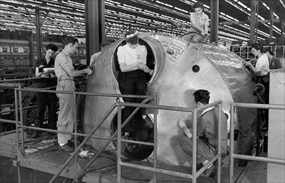 | 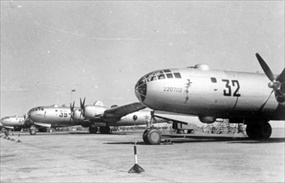 |
Left: A mixed crew of men and women work on the pressurized cockpit section of a B‑29 at the Bell plant in Marietta, Georgia. More than 600 of the 3,970 B‑29s were produced at the Marietta factory which, now owned by Lockheed Martin, still produces aircraft for the U.S. Air Force. B‑29s were retired from service in 1960. Two restored and flyable B‑29s, FIFI and Doc, have avoided the scrapyard to make the rounds of American airshows and museums.
![]()
Right: During 1944 and 1945 4 B‑29s made emergency landings in the Soviet Union after bombing raids on Japanese-occupied Manchuria (Manchukwo) and Japan. The Soviets, in view of their then nonaggression treaty with Japan, facilitated the American aircrews’ “escape” to Iran while keeping their aircraft and turning down persistent U.S. requests for the B‑29s’ return. Soviet engineers examined the seized bombers from head to foot and within 2 years had produced flyable replicas using reverse-engineering. The Soviets called their unlicensed carbon copy the Tupolev Tu‑4. NATO codenamed it “Bull.” By 1950 the Soviets had deployed more than 270 Tu‑4s in long-range aviation regiments. A total of 847 Tu‑4s were built when production ended in 1952. This photo shows a lineup of Tu‑4s at a Soviet base.
Inside a Boeing B-29 Superfortress Aircraft Factory
![]()

 History buffs, there is good news! The Daily Chronicles of World War II is now available as an ebook for $4.99 on Amazon.com. Containing a year’s worth of dated entries from this website, the ebook brings the story of this tumultuous era to life in a compelling, authoritative, and succinct manner. Featuring inventive navigation aids, the ebook enables readers to instantly move forward or backward by month and date to different dated entries. Simple and elegant! Click
History buffs, there is good news! The Daily Chronicles of World War II is now available as an ebook for $4.99 on Amazon.com. Containing a year’s worth of dated entries from this website, the ebook brings the story of this tumultuous era to life in a compelling, authoritative, and succinct manner. Featuring inventive navigation aids, the ebook enables readers to instantly move forward or backward by month and date to different dated entries. Simple and elegant! Click 











